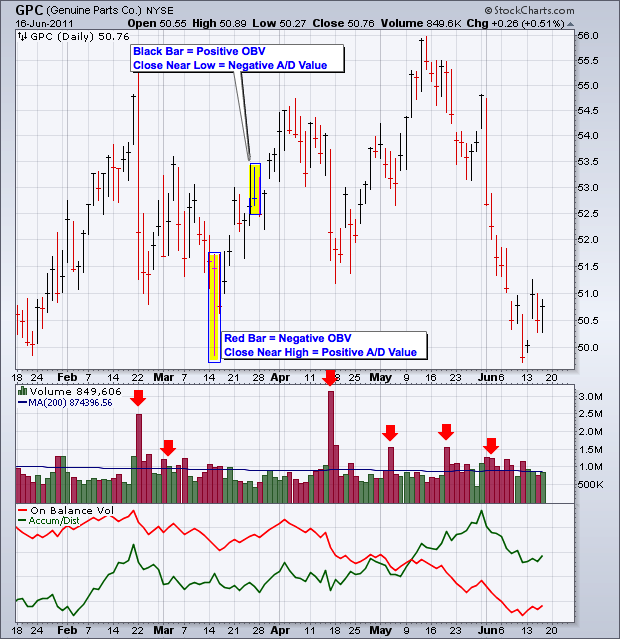|
|
Both the Accumulation Distribution Line and On Balance Volume (OBV) are volume-based indicators designed to measure the balance of power between buying pressure and selling pressure. These indicators can move different ways because they are calculated differently.
Let’s start with OBV, which is the simpler of the two. OBV is a cumulative indicator that adds a period’s volume when the close is higher and subtracts volume when the close is lower. On a daily basis, a down day on high volume will push OBV lower, while an up day on high volume will push OBV higher.
The chart below shows Genuine Parts (GPC) with open-high-low close bars, volume and the two indicators. Up closes are black and down closes are red. Notice how the stock declined on high volume from late February to June. There are dozens of red volume bars that exceeded the 200-day SMA of volume. These high-volume declines pushed OBV (red line) lower over the last few months.

Even though OBV moved lower, the Accumulation Distribution Line moved higher because this indicator is not concerned with the close from one period to the next. Instead, the Accumulation Distribution Line is based on the level of the close relative to the high-low range for the period. A volume multiplier is created based on this relationship. The volume multiplier is +1 when the close is on the high of the day, -1 when the close is on the low and 0 when the close is in the exact middle. A close in the upper half of the period’s range yields a positive number between 0 and +1, while a close in the lower half yields a negative number between 0 and -1. Volume is then multiplied by this number to create each period’s Accumulation Distribution value. The Accumulation Distribution Line rises when the value is positive and falls when the value is negative.
One indicator is not necessarily better than the other. Because these two indicators are calculated differently, chartists can use both to confirm or refute one another. Strength in both would show clear signs of buying pressure. Weakness in both would show clear signs of selling pressure. You can read more on On Balance Volume (OBV) and the Accumulation Distribution Line in our ChartSchool.


